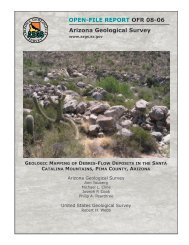geothermal resource potential of the safford-san simon basin, arizona
geothermal resource potential of the safford-san simon basin, arizona
geothermal resource potential of the safford-san simon basin, arizona
Create successful ePaper yourself
Turn your PDF publications into a flip-book with our unique Google optimized e-Paper software.
asal conglomerate facies <strong>of</strong> <strong>the</strong> lower <strong>basin</strong> fill.<br />
rfuere this occurs, important<br />
hydrologic connection no doubt exists to provide <strong>the</strong> ground water<br />
recharge and give <strong>the</strong> observed artesian pressure in <strong>the</strong> basal conglomerate<br />
facies.<br />
Basin-fill Sediments in <strong>the</strong> San Simon Area<br />
White (1963) uses an informal two-fold classification for sediments in<br />
<strong>the</strong> San Simon area.<br />
Basin-filling sediment are divided into younger alluvial<br />
fill and older alluvial fill.<br />
The younger alluvial fill category is restricted to sediment deposited<br />
by present-day washes or gravel-capping terraces or remnant erosional features.<br />
Technically, <strong>the</strong> younger alluvial fill category sediments are not <strong>basin</strong>-filling<br />
sediments because <strong>the</strong>y are sediments in transport out <strong>of</strong> <strong>the</strong> <strong>basin</strong>.<br />
True <strong>basin</strong>-filling sediments would be categorized by White<br />
(1963) as <strong>the</strong><br />
older alluvial fill sediments.<br />
White (1963) breaks <strong>the</strong> older alluvial fill<br />
sediments into four groups:<br />
(1) lower unit, (2) blue clay unit, (3) upper<br />
unit, (4) marginal zone.<br />
The lower unit is continuous throughout <strong>the</strong> <strong>basin</strong><br />
and probably correlates with <strong>the</strong> basal conglomerate facies <strong>of</strong> Harbour (1966)<br />
in <strong>the</strong> Safford area.<br />
Sand, gravel and clay comprise <strong>the</strong> lower unit and it<br />
contains water under artesian pressure which is tapped locally for irrigation.<br />
Total thickness <strong>of</strong> <strong>the</strong> lower unit varies, a maximum thickness <strong>of</strong> over 610<br />
meters is observed in <strong>the</strong> depositional <strong>basin</strong> center.<br />
The blue clay unit overlies <strong>the</strong> lower unit and attains a maximum thickness<br />
<strong>of</strong> 183 meters.<br />
Correlation <strong>of</strong> <strong>the</strong> blue clay unit with <strong>the</strong> green clay<br />
facies is probable because both "formation" tops occur near <strong>the</strong> same elevation<br />
and have similar deposition setting.<br />
Also, <strong>the</strong> lithology <strong>of</strong> <strong>the</strong> green<br />
clay facies and <strong>the</strong> blue clay unit is apparently identical.<br />
27

















